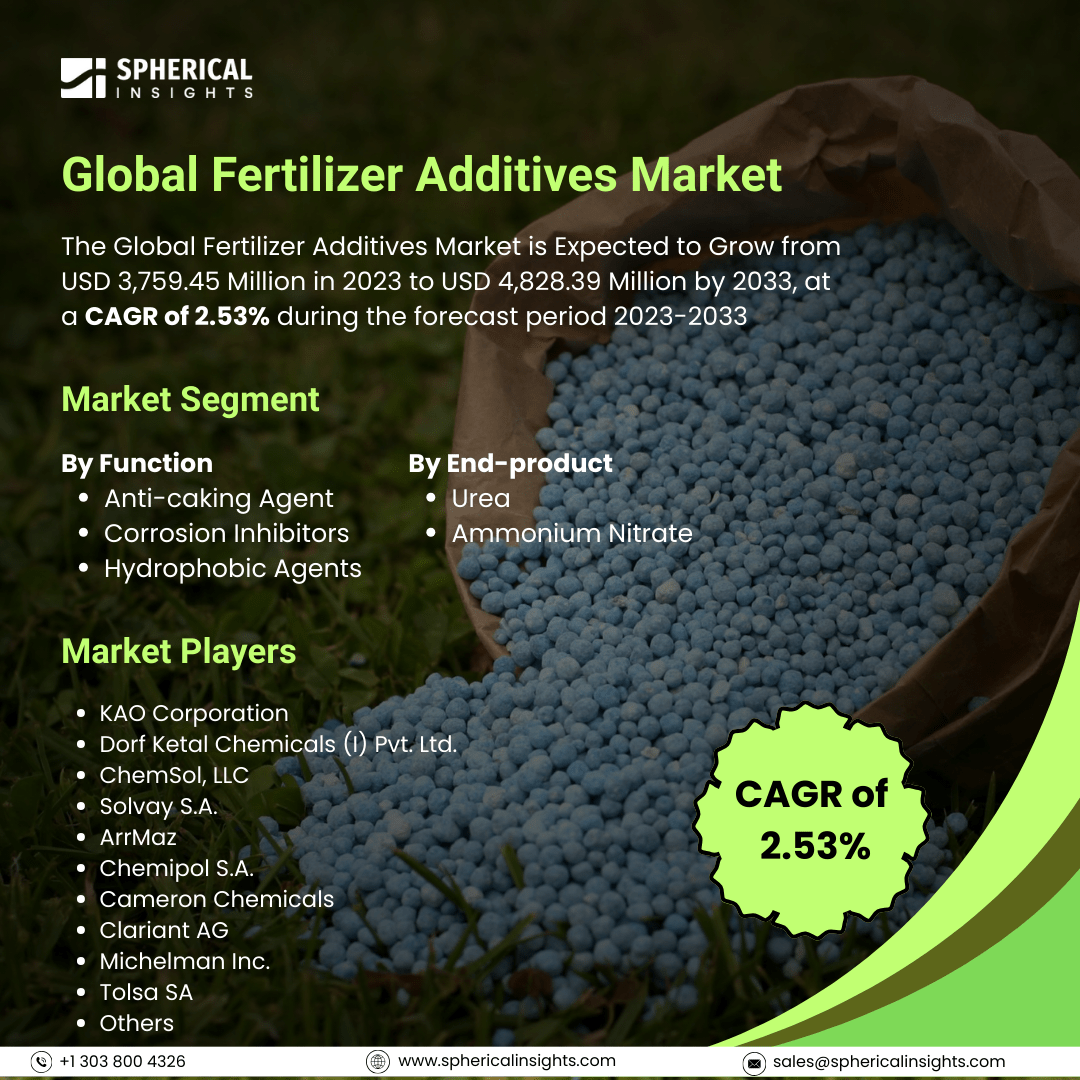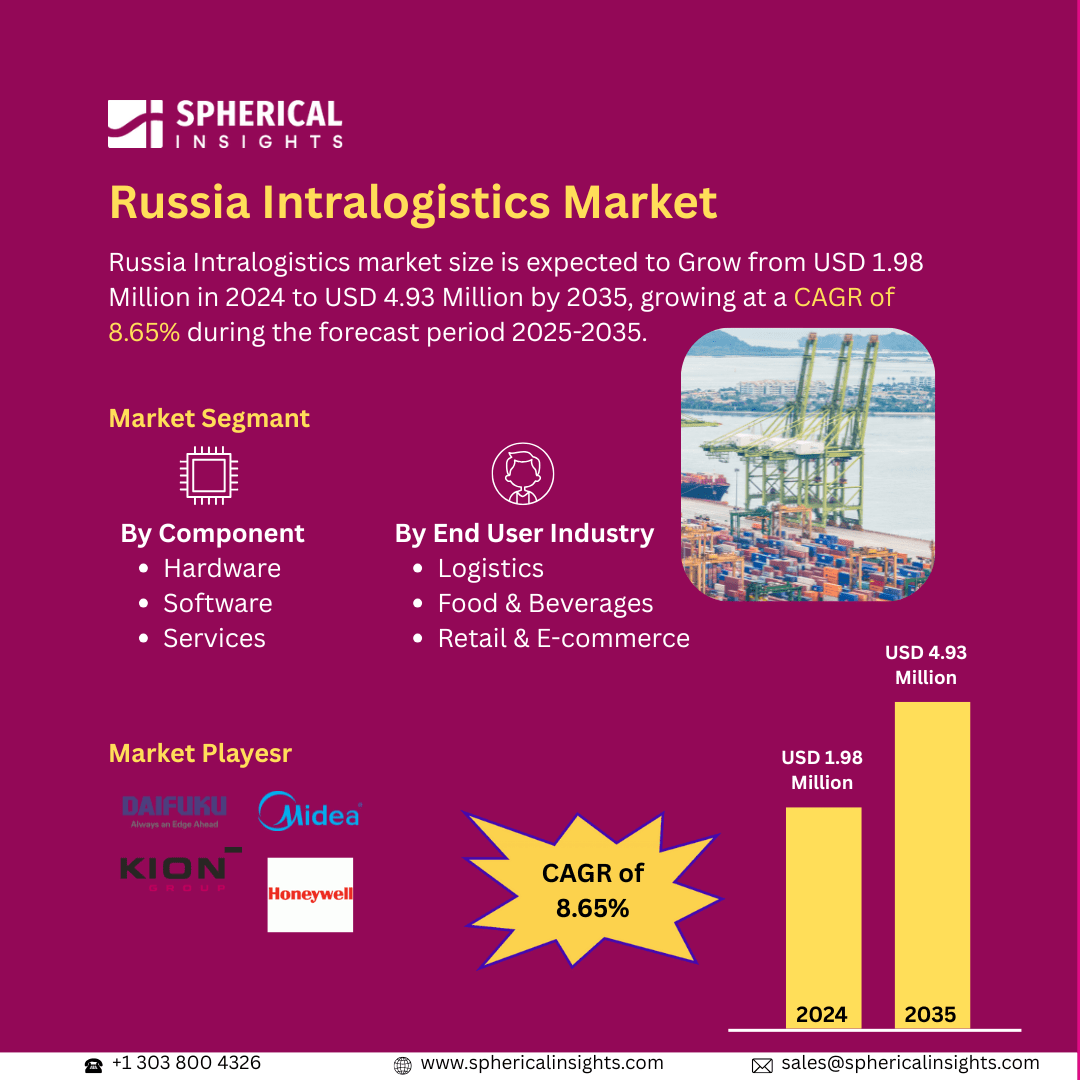Global Fertilizer Additives Market Size to Exceed USD 4,828.39 Million by 2033
According to a research report published by Spherical Insights & Consulting, The Global Fertilizer Additives Market Size is Expected to Grow from USD 3,759.45 Million in 2023 to USD 4,828.39 Million by 2033, at a CAGR of 2.53% during the forecast period 2023-2033.
Browse 210 Market Data Tables and 45 Figures Spread Through 190 Pages and In-Depth TOC On the Global Fertilizer Additives Market Size, Share, and COVID-19 Impact Analysis, By Function (Anti-caking Agent, Corrosion Inhibitors, and Hydrophobic Agents), By End-product (Urea, Ammonium Nitrate), and By Region (North America, Europe, Asia-Pacific, Latin America, Middle East, and Africa), Analysis and Forecast 2023 - 2033.
The fertilizer additives market includes the market for chemicals or substances that are added to fertilizers to improve their efficiency, stability, and nutrient release, thereby increasing crop yields and farm productivity. Fertilizer additives are chemicals that are used as additions to fertilizers to enhance their operation or to make structural changes. The shift in agricultural methods and concern for the quality & quantity of fertilizers are likely to drive the use of additives. Furthermore, fertilizer additives are seeing strong demand around the world as a result of the implementation of sustainable agriculture methods in emerging economies and efforts to increase crop yield per hectare. Firms in the ecosystem are putting a lot of money into research and development activities to improve the quality of feed additives and make them compatible with evolving agricultural practices. However, the market for fertilizer additives is threatened by stringent environmental laws, volatile raw material prices, efficient nutrient uptake, and minimal waste requirements, fueled by increased food demand and shrinking cultivatable land.
The anti-caking agent segment held the highest share in 2023 and is estimated to grow at a significant CAGR during the projected period.
Based on the function, the global fertilizer additives market is divided into anti-caking agent, corrosion inhibitors, and hydrophobic agents. Among these, the anti-caking agent segment held the highest share in 2023 and is estimated to grow at a significant CAGR during the projected period. Anti-caking, anti-dusting, corrosion inhibitors, and anti-coating are the main purposes of the product. Among them, the anti-caking function is the most important. This is because flakes are created during monsoon seasons when fertilizers are stored.
The urea segment held the largest share in 2023 and is estimated to grow at a significant CAGR during the forecast period.
Based on the end-product, the global fertilizer additives market is divided into urea and ammonium nitrate. Among these, the urea segment held the largest share in 2023 and is estimated to grow at a significant CAGR during the forecast period. Urea, being a nitrogenous fertilizer, is easily synthesized and readily available, hence a favorite among farmers. The urea market is likely to increase considerably in developing nations like India and Brazil.
North America is anticipated to hold the highest share of the global fertilizer additives market over the projected period.
North America is anticipated to hold the highest share of the global fertilizer additives market over the projected period. The U.S. dominates the North American market. Urea and ammonium nitrate were the most favored fertilizers in North America in 2023. Planning for crop management has emerged as an essential component of the governments of nations within the region, thereby contributing to the growth of the market in the forecast period positively.
Asia Pacific is estimated to grow at the fastest CAGR of the global fertilizer additives market during the forecast period. The need for additives is projected to grow in emerging markets such as China and India because their agriculture sector has been growing. Agriculture is an important sector that contributes heavily to the GDP of these economies such as Bangladesh, India, China, and Sri Lanka.
Company Profiling
Major vendors in the global fertilizer additives market are KAO Corporation, Dorf Ketal Chemicals (I) Pvt. Ltd., ChemSol, LLC, Solvay S.A., ArrMaz, Chemipol S.A., Cameron Chemicals, Clariant AG, Michelman Inc., Tolsa SA, and others.
Key Target Audience
- Market Players
- Investors
- End-users
- Government Authorities
- Consulting and Research Firm
- Venture capitalists
- Value-Added Resellers (VARs)
Recent Developments
- In November 2023, EuroChem Group AG introduced a new range of slow-release fertilizers for sustainable agriculture. EuroChem-BMU has completed pilot production to make mineral NPS fertilizers with elemental sulfur. The Russian market will provide the initial 4-kiloton lot of sulphur-based fertilizers. NPS compounds with nitrogen (N), phosphorous (P), and potash (K) also have added elemental sulfur, one of the most important nutrient supplements required for plant development. Oxidized sulfate sulfur helps plants to uptake nitrogen, phosphorus, and other required minerals more efficiently. The release of sulfur enhances the whole crop growth cycle without requiring reapplication, leading to greater yields in soils with low sulfur levels.
Market Segment
This study forecasts revenue at global, regional, and country levels from 2023 to 2033. Spherical Insights has segmented the global fertilizer additives market based on the below-mentioned segments:
Global Fertilizer Additives Market, By Function
- Anti-caking Agent
- Corrosion Inhibitors
- Hydrophobic Agents
Global Fertilizer Additives Market, By End-product
Global Fertilizer Additives Market, By Regional
- North America
- Europe
- Germany
- UK
- France
- Italy
- Spain
- Russia
- Rest of Europe
- Asia Pacific
- China
- Japan
- India
- South Korea
- Australia
- Rest of Asia Pacific
- South America
- Brazil
- Argentina
- Rest of South America
- Middle East & Africa
- UAE
- Saudi Arabia
- Qatar
- South Africa
- Rest of the Middle East & Africa



